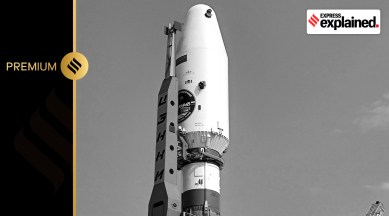What the Luna-25 crash tells us about Moon landings
Spacecraft had touched down on the Moon in the 1960s. Why then are modern space agencies struggling with soft-landing?

Luna-25, modern Russia’s first attempt to land a spacecraft on the Moon, has ended in failure with the spacecraft crashing onto the lunar surface, Russian space agency Roscosmos said on Sunday. The failure once again highlights the risks involved in getting a spacecraft to soft-land on the Moon.
Even though a successful landing has been achieved more than 20 times, including six times with human beings on board, the technology clearly has not been mastered yet. Amazingly, except the three Chinese landings in the past 10 years, all the successful landings on the Moon happened within a decade between 1966 and 1976.
15 minutes of terror
In the past four years, government and private space agencies from four countries — India, Israel, Japan and now Russia — have tried to land their spacecraft on the Moon, and failed. Each of these missions encountered problems in the very last stage — during the landing process — and crashed on the Moon’s surface.
The exact problem with Luna-25 is not yet known, though the statement from Roscosmos said that the change in momentum that the spacecraft had experienced while moving into the pre-landing orbit was different from what it should have been. In the case of the other three — ISRO’s Chandrayaan-2, Beresheet from Israel, and Hakuto-R from Japan — different kinds of malfunctions resulted in desired levels of speed not being achieved.
China has been the sole exception in this, having landed on its very first attempt in 2013 with Chang’e-3. It has repeated the feat with Chang’e-4 in 2019 and Chang’e-5, a sample return mission, in 2020.
Among the countries that have tried and failed, India is the only one which is already in the process of making a second attempt. Having learnt from its previous failure, it has incorporated several safety features in Chandrayaan-3, and added layers of redundancy so that if one particular feature develops problems, something else will work.
The earlier landings
It can seem strange that a technology capability that has been demonstrated on so many previous occasions half a century earlier continues to haunt some of the most advanced space agencies today. However, the landing technology was far from having been mastered even then. That is evident from the very high failure rate during that time.
Out of the 42 attempts to land between 1963 and 1976, only 21 succeeded, giving a success ratio of just 50 per cent. The motivations for going to the Moon at that time were very different. It was mainly the Cold War rivalry, and the desire to gain geopolitical advantage, that was pushing the United States and the erstwhile USSR to send these Moon missions. They were dangerous, extremely expensive, and energy inefficient. But some of these were also wildly successful, achieving feats that were in the realm of science fiction just a few years ago.
As Mylswamy Annadurai, one of the key people behind Chandrayaan-1, said, the kind of risks taken in sending those Moon missions would be completely unacceptable now. Even the expenditure incurred on those missions cannot be justified now.
Also, the technologies being used for the current round of Moon missions are very different. They are safer, cheaper and more fuel efficient. But that also means that these cannot be compared with those used in the 1960s and 1970s, and are being tested only now. That is the reason why even the United States, which landed as many as six crewed missions on the Moon, has started almost from scratch — by sending Orbiters — in the current round of Moon missions. Even with its Artemis programme, it has not begun by sending human beings. The crewed mission would go only on the Artemis-3 mission.
The future of Luna missions
Luna-25 was just the resumption of Russian interest in the Moon. It was named to signify the continuation of the Luna series which the then Soviet Union used to reach the Moon 50 years ago. Luna-24, launched in 1976, was the last spacecraft to land on the Moon’s surface, before lunar missions came to an abrupt halt and remained suspended for almost two decades.
Russia has already announced that there are more lunar missions to follow Luna-25. At least three more in the Luna series are planned in this decade.